 All you have to do is peel and enjoy. 
Above: another brilliant hardcover dust jacket from illustrator Barbara Walton, this time for John D. MacDonald's The Beach Girls, for British publisher Robert Hale, Ltd. The book was originally published in the U.S. in 1959, but the above edition came in 1968. To see more from Walton just click her keywords below, and to learn about the book click here.
 How does an angel get its wings? Via cleverly repurposed cover art. 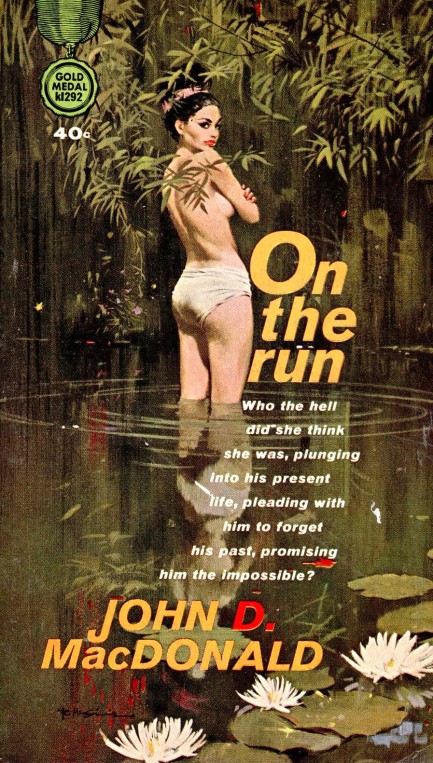 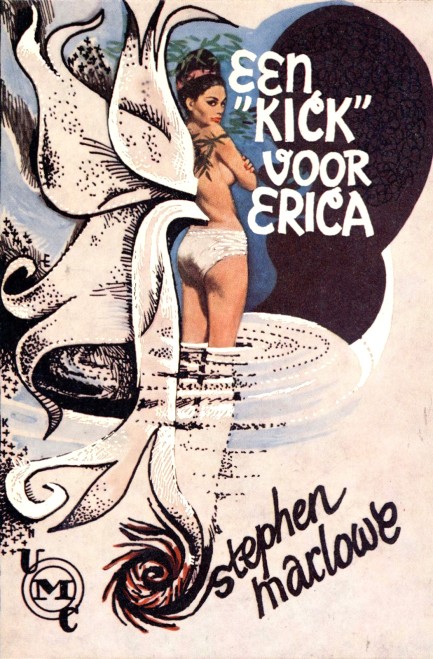
European and Australian publishers made a habit of reusing U.S. paperback art, and you see another example above. The top piece for John D. MacDonald's 1963 novel On the Run received a remix on the front of 1968's Een “kick” voor Erica, which is a translation by Dutch publishers Combinatie of Stephen Marlowe's 1967 novel Drumbeat — Erica. It's hard to improve on a McGinnis, but we think the fantasy-like transformation and giant wings—dare we say?—elevate cover number one to something even nicer. We found both on Flickr, so thanks to those two uploaders.
 I take it from the way you're sprawled across the front seat that dinner and a movie is no longer the plan. 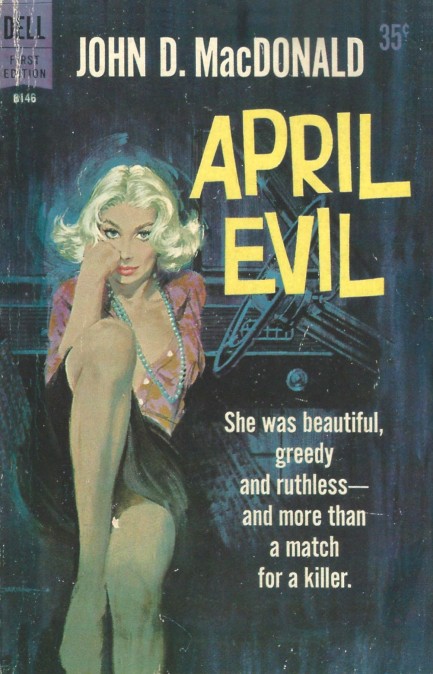
April Evil is a book that showcases John D. MacDonald on literary cruise control, as he confidently weaves together the tale of an elderly, widowed ex-doctor whose has a safe in his study filled with cash, the greedy relatives that hope he leaves his loot and property to them, and how, because rumors of the money have spread, three criminals decide to rob his house. Matters are even more complicated because the doctor has taken in a young married couple, and while the wife is not scheming to get his fortune, the husband is, and he has a big mouth. That mouth entices a psychopathic killer into hijacking the robbery scheme, with the ultimate plan of killing both his partners and—probably—everyone living in the house. For people acquainted with MacDonald but who haven't read April Evil, the approach will be familiar, particularly the character crosscurrents and fateful timing. It's well written, enjoyable, and free of pseudo-sociological content, which we consider to be a problem with McDonald's Travis Magee novels. We recommend it, even more so if you can score Dell's 1956 edition with Robert McGinnis cover art.
 The cover art for Murder in the Wind changes like the weather. 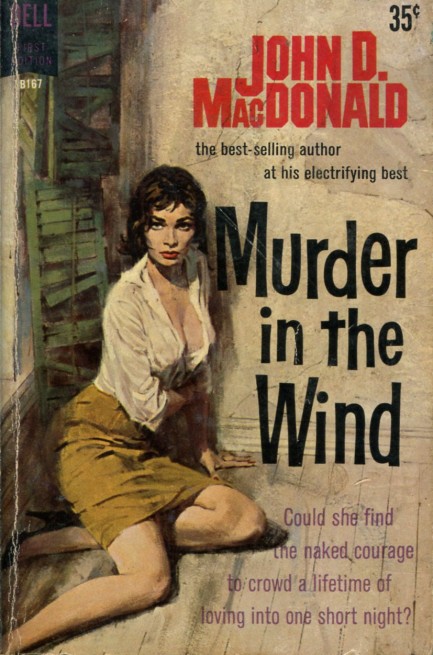 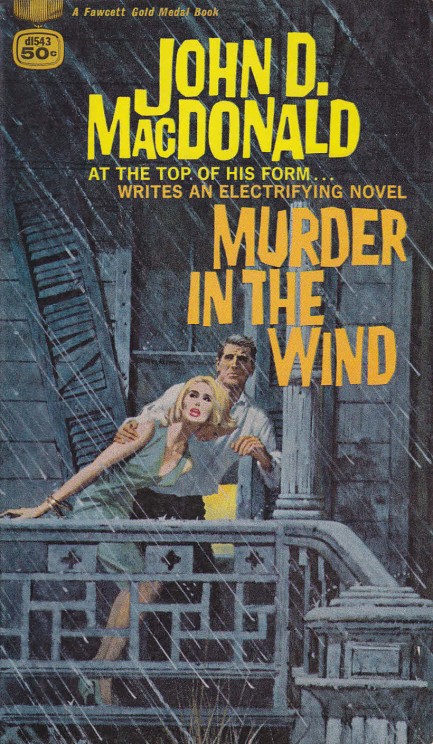
The copy we read of John D. MacDonald's natural disaster thriller Murder in the Wind a while back had a front painted by George Gross. The two covers you see above were painted by Bob Abbett and Robert McGinnis. Their art goes in different directions. Abbett's shows nothing related to bad weather but uses a dilapidated background to imply that his cover figure is stranded, while McGinnis went for an outdoor setting cut by slanting rain, also using a dilapidated house motif. Both efforts are excellent, and the book is good too, as we mentioned here.
 Southwest Florida gets obliterated but most of the wreckage is human in MacDonald disaster drama. 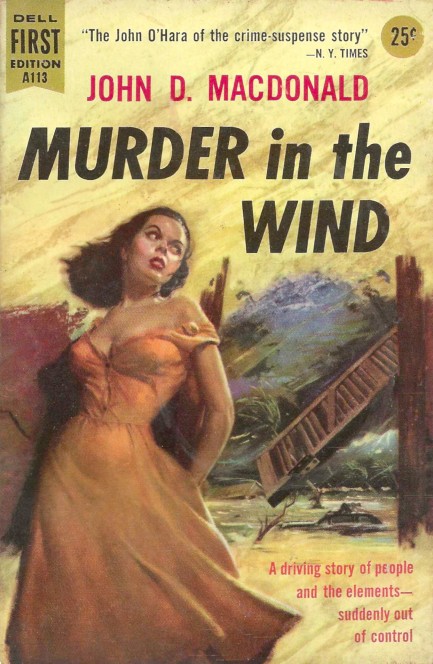
The three weather based thrillers we've discussed—A Town Is Drowning, Tropical Disturbance, and Death at Flood Tide—represent a minor fraction of the total in mid-century fiction. It's no surprise, then, that an author as prolific as John D. MacDonald also tested the waters. Murder in the Wind, also known as Hurricane, came in 1956 during the more fertile, less censorious period for MacDonald, and presents readers with a disparate selection of people who all hole up in an abandoned house during a hurricane named Hilda. Eventually the house is swept away entirely, but the story is never less than solidly grounded and engrossing. If your time is limited you might skip this one in favor of The Damned, which is a close cousin, conceptually speaking, but otherwise Murder in the Wind is a necessary read. You get all the fulfillment you'd want from a disaster drama.
 What a perfect day. It's days like this that make me glad we invested early in cryptocurrency and retired before thirty. 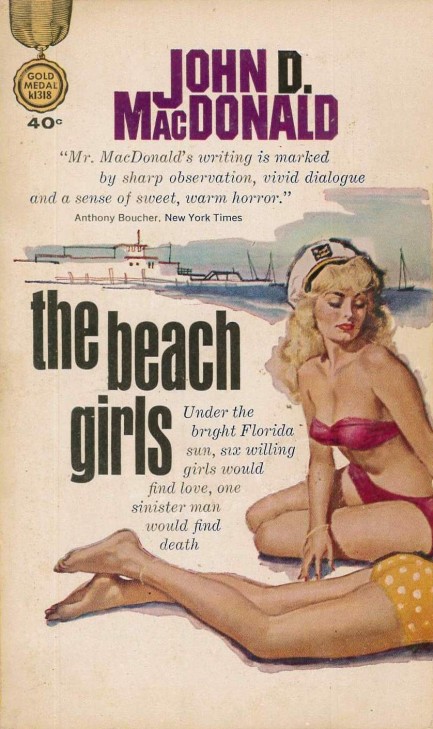
Above is a Charles Binger cover for John D. MacDonald's 1959 novel The Beach Girls. At this point, we know anything he wrote pre-Travis McGee is going to be good, and even the McGee books are mostly entertaining despite the main character's off-putting social judgments. The Beach Girls is a bit different from other MacDonalds we've read, largely written in a sort of round robin style where the final words of each chapter lead mid-sentence into the first words of the next, but with a change in first person point-of-view. The book cycles through numerous characters via this interesting trick before settling into standard third person narration for the finish.
The story deals with the inhabitants of a marina in fictional Elihu Beach, Florida, some of whom are friends, others enemies, some longtime residents, others newcomers, and how jealousy and resentment lead to a shocking act of violence. From the earliest pages you know this event is coming, and as the book wears on you become pretty sure who's going to be the unfortunate though deserving recipient, and who's going to be the giver. The main question becomes whether MacDonald will subvert these expectations and throw readers a curve. We'll just say it wasn't a predictable tale.
The only thing we don't get is why it's called The Beach Girls. The nearby beach area of the town is mentioned only a few times, no scenes are set there, and the book has an ensemble cast, with the women no more important than the men. There are groups of tourist women that pop up here and there, but they don't impact the story at all. Oh well. The title is a mystery, but an unimportant one. We'll get back to MacDonald a bit later. These 1950s efforts of his have been very worthwhile.
 Going under for the second time. 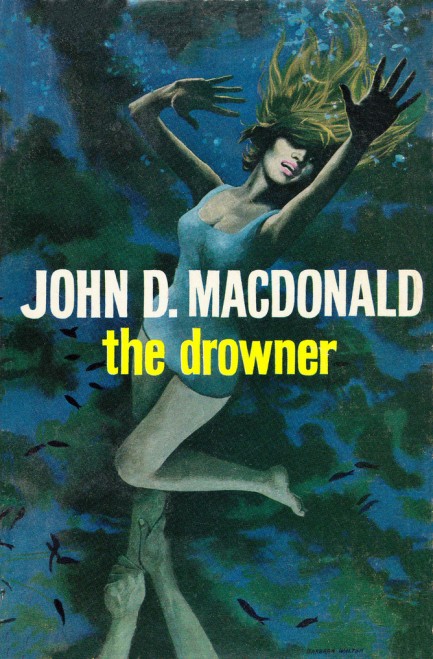
John D. MacDonald was a widely read author whose popularity endured, which means there are multiple editions of most of his books. We already showed you a cover for his 1963 thriller The Drowner. Here's a second version. This came from publisher Robert Hale Ltd. of England in 1964, and the art is by the incomparable Barbara Walton.
 Wow. And to think I criticized my last boyfriend for not showing his emotions. 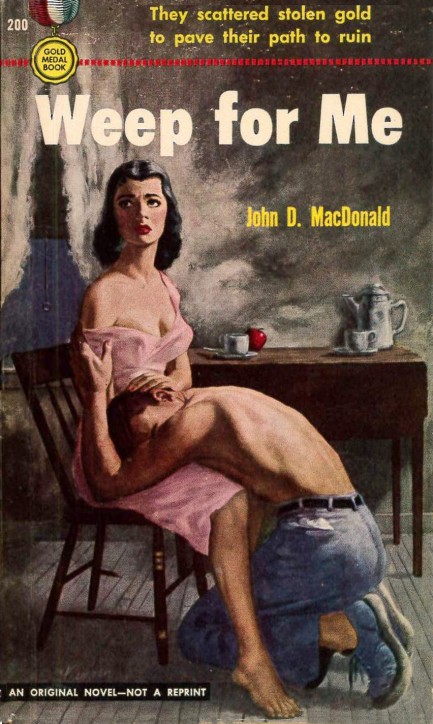
Above, a cover for Weep for Me by John D. MacDonald, for Gold Medal Books with art by Owen Kampen featuring a female figure who looks completely over it. This has the feel of an exact moment from the narrative, but we haven't read it. However, we do have a copy we're going to get to at some point. When we do we'll report back on this fraught scene.
 One esoteric murder method begets another. Possibly. 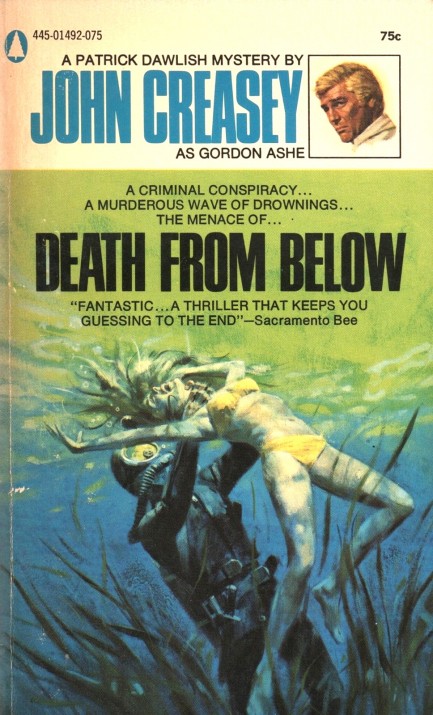
Concepts for thrillers can be hard to come by, so sometimes authors borrow from one another. Not long ago we read John D. MacDonald's The Drowner and shared the cover from the Gold Medal edition. Here you see British author John Creasey's, aka Gordon Ashe's, Death from Below. If you quickly click this link you'll notice the two books have identical art, thematically—a woman being pulled down into the water by an unidentified killer.
We figured Creasy borrowed from MacDonald, but interestingly, both books were originally published in 1963. Assuming months were spent actually writing them, it seems as if both authors simply had the same idea (we don't know if there was an earlier thriller with the same concept, but we wouldn't be surprised). The main difference between the tales is that MacDonald's killer drowns one person, where Creasy's goes full serial and drowns dozens, including children. His story also takes place in France, rather than the U.S., and has a deep—if unlikely—political element.
We know this scenario didn't happen, but we like to imagine both MacDonald and Creasy/Ashe walking into bookstores on opposite sides of the Atlantic sometime soon after both paperback editions had been released, seeing each other's on a shelf, and being mightily perturbed. At that point we like to imagine Creasy, in time-honored British fashion, saying, “MacDonald! That cheeky bugger!” MacDonald on the other hand, being American, probably went, “Creasy! That sneaky motherfucker!” Advantage: yanks.
 A favor turns fatal in MacDonald mystery. 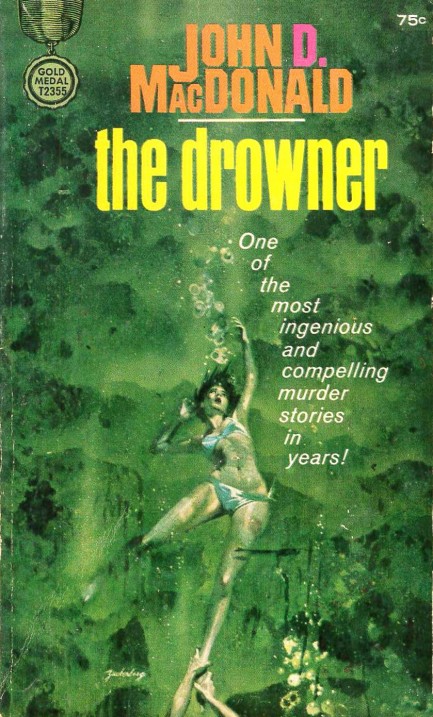
This is just the sort of eye-catching cover any publisher would want from an illustrator, an image that makes the browser immediately curious about the book. Since so many John D. MacDonald novels were illustrated by Robert McGinnis, and the female figure here has the sort of elongation you usually see from him, you could be forgiven for assuming at a glance that this is another McGinnis, but it's actually a Stanley Zuckerberg effort, clearly signed at lower left. We've run across only a few of his pieces, namely The Strumpet City and Cat Man. This is by far the best we've seen.
The story here is interesting. It begins with a woman having drowned in a lake and a sister who disbelieves the verdict of accidental death. She's right, of course, and the detective she hires soon agrees with her. The mystery is quickly revealed to involve taxes, deception, and money—specifically money the dead woman was supposed to keep safe and which has now disappeared. In an unusual move, MacDonald unveils the killer two thirds of the way through the tale, and the detective figures it out shortly thereafter. The final section of the book details his efforts to trap the villain.
This is the last book MacDonald wrote before embarking on his famed Travis McGee franchise. It was within the McGee persona that MacDonald indulged himself in often tedious sociological musings. In The Drowner his characters ring more true, but you can see signs of what is to come in several existential soliloquies concerning the state of the world and the various frail personality types that inhabit it circa 1963. For all our misgivings about the McGee books, they're still good. But we especially recommend any novel MacDonald wrote that came earlier, including this one.
Update: We got an e-mail from Pamela, who told us, "The plot seemed familiar, and sure enough - it was an episode of Kraft Suspense Theatre back in 1964."
We had a look around for it, with no expectations of success, but lo and behold, we found the episode on Archive.org, which often has public domain films and television shows on its platform. We watched the episode, which stars Aldo Ray, Clu Gallagher, and Tina Louise, and we have to say, John. D. MacDonald was probably thrilled. The adaptation is almost exact, with only a bit of license taken with the climax. The only thing he would have hated is that he's credited as John P. MacDonald. The only thing we hated was the lo-rez quality. Oh well. You can't ask for perfection when it comes to early television.

|
 |

The headlines that mattered yesteryear.
2003—Hope Dies
Film legend Bob Hope dies of pneumonia two months after celebrating his 100th birthday. 1945—Churchill Given the Sack
In spite of admiring Winston Churchill as a great wartime leader, Britons elect
Clement Attlee the nation's new prime minister in a sweeping victory for the Labour Party over the Conservatives. 1952—Evita Peron Dies
Eva Duarte de Peron, aka Evita, wife of the president of the Argentine Republic, dies from cancer at age 33. Evita had brought the working classes into a position of political power never witnessed before, but was hated by the nation's powerful military class. She is lain to rest in Milan, Italy in a secret grave under a nun's name, but is eventually returned to Argentina for reburial beside her husband in 1974. 1943—Mussolini Calls It Quits
Italian dictator Benito Mussolini steps down as head of the armed forces and the government. It soon becomes clear that Il Duce did not relinquish power voluntarily, but was forced to resign after former Fascist colleagues turned against him. He is later installed by Germany as leader of the Italian Social Republic in the north of the country, but is killed by partisans in 1945.
|

|
|

It's easy. We have an uploader that makes it a snap. Use it to submit your art, text, header, and subhead. Your post can be funny, serious, or anything in between, as long as it's vintage pulp. You'll get a byline and experience the fleeting pride of free authorship. We'll edit your post for typos, but the rest is up to you. Click here to give us your best shot.

|
|



























































































